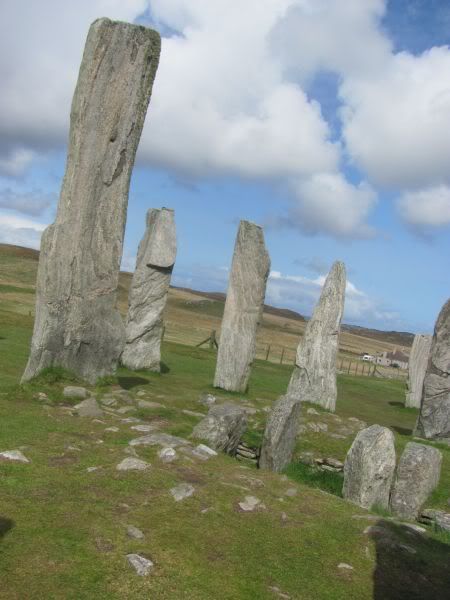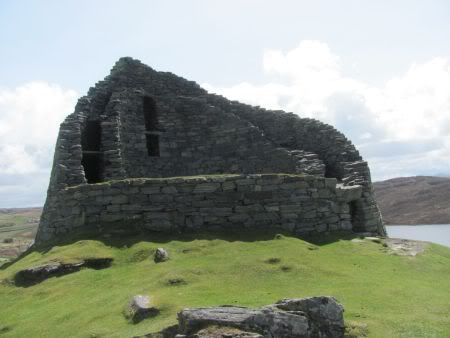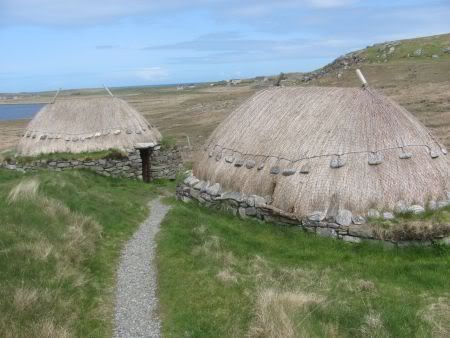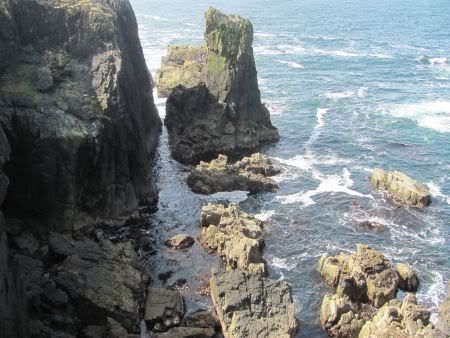Photos from the Isle of Lewis in the Scottish Hebrides
believe it or not, the photos below were only from yesterday...
Callanish Stones
Construction of the site took place between 2900 and 2600 BC, though there were possibly earlier buildings before 3000 BC. A tomb was later built into the site. Debris from the destruction of the tomb suggests the site was out of use between 2000 BC and 1700 BC.[1] The 13 primary stones form a circle about 13 m in diameter, with a long approach avenue of stones to the north, and shorter stone rows to the east, south, and west (possibly incomplete avenues). The overall layout of the monument recalls a distorted Celtic cross. The individual stones vary from around 1 m to 5 m in height, with an average of 4 m, and are of the local Lewisian gneiss.

Dun Carloway broche
Dun Carloway (in Scottish Gaelic Dùn Chàrlabhaigh) is a broch situated in the district of Carloway, on the west coast of the Isle of Lewis, Scotland. It is a remarkably well preserved broch - on the east side parts of the old wall still reaches to 9 metres tall. In places there are also more modern repairs to the east wall. Dun Carloway was probably built some time in the 1st century BC, and radiocarbon dating evidence from remains found in the broch show that it was last occupied around 1300 AD. At the base the broch is around 14 to 15 metres in diameter and the walls around 3 metres thick. It has a circular plan and hollow walls and was built without mortar. It probably had wooden floors, internal partitions and a thatched roof, necessary to make it habitable, but the only remaining evidence of this are post-holes. Together with the roof, the narrow passageway presumably secured by a wooden door, were the most vulnerable points of the building, especially to fire.

Shawbost Norse Mill and KilnShawbost Mill was first restored in the late 1960s, but the current restoration dates back to 1995. The high quality path was added in 2003.
The building you see on your right as you approach is the kiln. It isn't immediately obvious how this worked, but half the floor area comprises a raised stone platform within which is set a circular stone-lined pit. This presumably contained the fire that heated and dried the grain spread out around the remainder of the kiln.The mill is more immediately spectacular, though here much of the workings are set in a chamber below floor level. Water from the nearby burn was led into a mill lade some way upstream from the mill. It was then channelled to the top of a mill race just behind the mill itself. From here a steep chute directed it down onto one side of a circular set of paddles, set horizontally in a chamber directly beneath the mill.
The water turned the paddles, which caused the upper of the two millstones in the mill itself to turn, which in turn ground the grain. Part of the mechanism joggled the wooden hopper located above the millstones, which ensured the flow of grain into hole in the centre of the stones. The flour which was produced was gathered by the kerb stones around the lower millstone and gathered in front of it.
Shawbost Mill is not the largest or best known of Lewis's visitor attractions, but a visit does provide a fascinating insight into away of life once very common on the island.

Port Ness Lighthouse and Butt of Lewis
Here you find an intriguing little harbour, the entrance to which is through the gap between a cliff face and a large rocky islet. One end of the harbour merges into an extremely attractive east-facing beach.
[...]Settlement in Nis is very dispersed, and you can think of Port Nis as being at the end of a single linear settlement that extends for over three miles back down the main road to Swainbost, Cros and beyond. It also extends south of the main road and, to the north, to Europie or Eoropaidh. Here you find the beautifully restored St Moluag's Church, on a site believed to have been consecrated since the arrival of St Moluag in the 560s.
North from Europie a minor road runs the mile to the Butt of Lewis lighthouse. This 121 foot tower was designed by David Stevenson and first lit in 1862. The tower is made of exposed brick, a surface that gives it an oddly unfinished air, but one which has served it well for over 140 years.


Labels: antiquities, Hebrides, Scotland, United Kingdom
Submit To PropellerTweet














